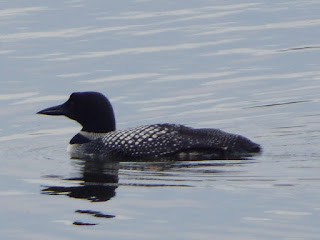 |
| Photo by Julie E. Smith |
My first introduction to the beauty of loons came several years ago while visiting my husband's uncle in Maine. They have a cabin on a woodland lake there and the loons are seen on a daily basis. We saw them several times while visiting there, but we were much more likely to hear there calls in the evening, then actually see them. When I moved to the north woods of Wisconsin, on a lake, ....my fascination with these amazing waterbirds grew. The more I find out about them I realize they really are amazing creatures.
 |
| Photo by Julie E. Smith |
Obviously they are water birds and excellent at diving and fishing. Their bodies are built for diving and they can remain submerged for up to 3 minutes. Yet, it's interesting that loons are not like other aquatic birds in that they can not walk on land. They are very awkward on land; very top heavy because their feet are positioned at the back of their body. Perfect for swimming and diving, not so much for walking. Last summer, my neighbor and I discovered a loon that had apparently overshot the lake and landed on the side of the road. He didn't seem injured, just "stuck" and could only weakly waddle. We didn't know what to do, so we called the DNR and they sent someone out. When the loon realized we were trying to capture him to assist, he became frightened and waddled much more quickly to the water, dove in and was fine. In hindsight, I found out that if a Loon gets too far from water, he just needs to get put back in. The safest and most effective way is just to cover with a blanket and gently put in the water. Better yet, call the DNR for assistance if you are not sure. In any case, I am glad that story had a happy ending.
 |
| Loon w/chick, photo from Mother Nature Network, Brian Lasenby |
There are plenty of fish out there for both humans and loons, but since Loons fish in the same lakes as humans, certain threats to the loons have surfaced. The use of lead sinkers is the leading cause of adult mortality in loons. To aid digestion, loons ingest small stones from the bottom of the lake. A small lead sinker is easily confused with small stones. A single split shot sinker can kill a loon. The Wisconsin DNR has a link to assist and inform anglers about easy and economical alternatives to lead. Not only does it help loons but other aquatic life including ducks, turtles and bald eagles. You can find this information at: https://dnr.wi.gov/topic/fishing/documents/fishhealth/gettheleadout.pdf
The use of lead buck shot by hunters, subsequently consumed inadvertently by carnivores such as bald eagles, is being phased out gradually and other types of ammunition are being developed. Perhaps that needs to be pursued with lead sinkers.
So many Native American stories surround the Loon. Yet my favorite is how the loon got it's distinct feather colorization "necklace." Ancient stories told of loons that would restore the sight of blind persons. Loons would carry the afflicted to the bottom of the lake several times to let the water wash over their eyes and restore their sight.
 |
| Just look at that beautiful necklace! Photo from Wildernessclassroom.com |
Last year for my birthday, my sister purchased for me a Loon call whistle. Kind of a slide whistle of sorts. Actually it's pretty cool and I am trying to perfect my call. I have yet to hear a loon answer me. They are probably swimming in a circle, laughing and saying to themselves...dumb human, who is she trying to fool? Yet, I will keep on trying to say "Hey, what's Up?" in Loon-Speak.
Sources: Fascinating Loons, by Stan Tekiela 2006
Wisconsin Department of Natural Resources @ dnr.wi.gov